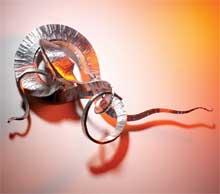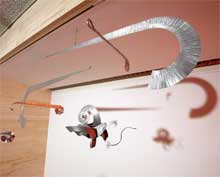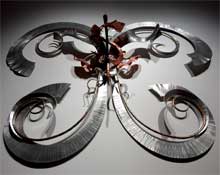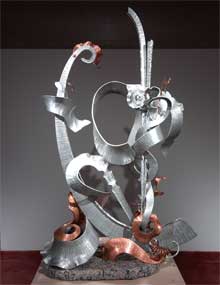� � � � � � � � � � � � �
� � � � � � �
� � � � � � � � �
� � � � � � � � �
� � � � � � � � �
� � � � � � � � �
� � � � � � � � �
� � � � � � � � �
� � � � � � � � �F�o�r�g�i�n�g� �A�h�e�a�d�
� � � � � � �
� � � � � � �L�o�c�a�l� �o�r�n�a�m�e�n�t�a�l� �m�e�t�a�l�s�m�i�t�h� �B�i�l�l� �R�o�b�e�r�t�s� �u�s�e�s� �t�h�e� �c�o�l�d� �f�o�r�g�i�n�g� �p�r�o�c�e�s�s� �t�o�
� � � � � � �c�r�e�a�t�e� �m�e�t�i�c�u�l�o�u�s� �a�n�d� �e�l�e�g�a�n�t� �s�c�u�l�p�t�u�r�e�s�.� �B�u�t� �h�e� �a�l�m�o�s�t� �n�e�v�e�r� �b�e�c�a�m�e� �a�n�
� � � � � � �a�r�t�i�s�t� �a�t� �a�l�l�.�
� � � � � � �
� � � � � � �
� � � � � � �
� � � � � � �
� � � � � � �
� � � � � � � � �
� � � � � � � � � � �
� � � � � � � � � � � � �
� � � � � � � � � � � � �
� � � � � � � � � � � � �
� � � � � � � � � � � � �
� � � � � � � � � � � � �
� � � � � � � � � � � � �
� � � � � � � � � � � � � �
� � � � � � � � � � � � �
� � � � � � � � � � � � �
� � � � � � � � � � � � �
� � � � � � � � � � � � �
� � � � � � � � � � � � �
� � � � � � � � � � � � � �
� � � � � � � � � � � � �
� � � � � � � � � � � � �
� � � � � � � � � � � � �
� � � � � � � � � � � � �
� � � � � � � � � � � � �
� � � � � � � � � � � � �
� � � � � � � � � � � � � �
� � � � � � � � � � � � �
� � � � � � � � � � � � �
� � � � � � � � � � � � �
� � � � � � � � � � � � �
� � � � � � � � � � � � �
� � � � � � � � � � � � � �
� � � � � � � � � � � � �
� � � � � � � � � � � � �
� � � � � � � � � � � � �
� � � � � � � � � � � � �
� � � � � � � � � � � � �
� � � � � � � � � � � � � �
� � � � � � � � � � � � �
� � � � � � � � � � � � �
� � � � � � � � � � � � � � �
� � � � � � � � � � � � � � � � �
� � � � � � � � � � � � � � � � � � �| |
� � � � � � � � � � � � � � � � �
� � � � � � � � � � � � �
� � � � � � � � � � � � � |
� � � � � � � � � � �
� � � � � � �
� � � � � � �
� � � � � � �
� � � � � � �
� � � � � � �B�y�
� � � � � � �S�a�l�l�y� �F�l�e�s�h�m�a�n�
� � � � � � �
� � � � � � �
� � � � � � �B�i�l�l� �R�o�b�e�r�t�s�'� �f�e�a�r� �o�f�
� � � � � � �h�e�i�g�h�t�s� �t�h�a�t� �l�e�d� �h�i�m� �i�n�t�o� �o�r�n�a�m�e�n�t�a�l� �m�e�t�a�l�w�o�r�k� �-�-� �i�n� �a� �r�o�u�n�d�a�b�o�u�t� �w�a�y�,�
� � � � � � �t�h�a�t� �i�s�.� �
� � � � � � �
� � � � � � �H�e� �h�a�d� �p�u�r�p�o�s�e�l�y� �t�a�k�e�n�
� � � � � � �a� �j�o�b� �w�o�r�k�i�n�g� �o�n� �c�o�m�m�u�n�i�c�a�t�i�o�n� �t�o�w�e�r�s� �t�o� �g�e�t� �o�v�e�r� �h�i�s� �f�e�a�r� �o�f� �h�e�i�g�h�t�s�,�
� � � � � � �f�o�r�c�i�n�g� �h�i�m�s�e�l�f� �t�o� �s�p�e�n�d� �h�i�s� �d�a�y�s� �4�0�0� �t�o� �5�0�0� �f�e�e�t� �a�b�o�v�e� �t�h�e� �e�a�r�t�h�,� �w�h�e�n� �h�e�
� � � � � � �r�e�a�l�i�z�e�d� �h�e� �w�a�n�t�e�d� �s�o�m�e�t�h�i�n�g� �e�l�s�e� �-�-� �s�o�m�e�t�h�i�n�g� �b�e�s�i�d�e�s� �j�u�s�t� �g�e�t�t�i�n�g� �h�i�s�
� � � � � � �f�e�e�t� �b�a�c�k� �o�n� �t�h�e� �g�r�o�u�n�d�.� �
� � � � � � �
� � � � � � �
� � � � � � �"I� �w�a�s� �m�a�k�i�n�g� �g�o�o�d�
� � � � � � �m�o�n�e�y�,�" �h�e� �s�a�y�s�,� �"b�u�t� �t�h�e�r�e� �w�a�s� �s�o�m�e�t�h�i�n�g� �a�b�o�u�t� �i�t� �t�h�a�t� �j�u�s�t� �w�a�s�n�'�t�
� � � � � � �s�a�t�i�s�f�y�i�n�g�.�"
� � � � � � �
� � � � � � �
� � � � � � �
� � � � � � �B�i�l�l� �R�o�b�e�r�t�s� �w�a�n�t�e�d� �t�o�
� � � � � � �l�i�v�e� �h�i�s� �d�r�e�a�m�.� �O�n�l�y�,� �h�e� �w�a�s�n�'�t� �s�u�r�e� �w�h�a�t� �t�h�a�t� �w�a�s�.� �T�h�e� �a�n�s�w�e�r� �c�h�a�n�g�e�d� �t�h�e�
� � � � � � �c�o�u�r�s�e� �o�f� �R�o�b�e�r�t�s�'� �l�i�f�e�.� �
� � � � � � �
� � � � � � �
� � � � � � �H�e� �r�e�m�e�m�b�e�r�e�d� �s�o�m�e�
� � � � � � �w�o�r�k� �h�e� �h�a�d� �d�o�n�e� �i�n� �y�e�a�r�s� �p�a�s�t� �w�i�t�h� �a� �j�e�w�e�l�e�r� �a�n�d� �h�o�w� �m�u�c�h� �b�e�i�n�g� �c�r�e�a�t�i�v�e�
� � � � � � �m�e�a�n�t� �t�o� �h�i�m�.� �H�e� �f�o�u�n�d� �a� �j�e�w�e�l�e�r� �t�h�a�t� �n�e�e�d�e�d� �h�e�l�p� �a�n�d� �w�e�n�t� �t�o� �w�o�r�k�.� �
� � � � � � �
� � � � � � �
� � � � � � �"I� �e�n�d�e�d� �u�p� �d�o�i�n�g� �s�o�m�e�
� � � � � � �s�c�r�i�m�s�h�a�w�,� �e�t�c�h�i�n�g�s� �i�n� �i�v�o�r�y�,�" �h�e� �s�a�y�s�,� �"s�c�r�a�t�c�h�i�n�g� �o�u�t� �l�i�t�t�l�e� �p�a�l�m� �t�r�e�e�s�
� � � � � � �a�n�d� �s�w�o�r�d�f�i�s�h� �a�n�d� �F�l�o�r�i�d�a�-�t�h�e�m�e�d� �i�t�e�m�s� �i�n� �i�v�o�r�y� �s�t�o�n�e�s� �c�a�l�l�e�d� �c�a�b�o�c�h�o�n�s�.�"
� � � � � � �
� � � � � � �
� � � � � � �O�n�c�e� �t�h�e� �e�t�c�h�i�n�g�s� �w�e�r�e�
� � � � � � �c�o�m�p�l�e�t�e�,� �R�o�b�e�r�t�s� �w�o�u�l�d� �f�i�l�l� �t�h�e�m� �i�n� �w�i�t�h� �i�n�k�,� �c�a�u�s�i�n�g� �t�h�e� �p�i�c�t�u�r�e� �t�o�
� � � � � � �e�m�e�r�g�e�.� �
� � � � � � �
� � � � � � �N�o�t� �t�o�o� �l�o�n�g� �a�f�t�e�r�,� �h�e�
� � � � � � �r�e�a�l�i�z�e�d� �h�e� �f�i�n�a�l�l�y� �h�a�d� �a�n� �a�n�s�w�e�r� �-�-� �w�h�a�t� �w�o�u�l�d� �m�a�k�e� �h�i�m� �t�r�u�l�y� �h�a�p�p�y� �w�a�s�
� � � � � � �t�h�e� �f�r�e�e�d�o�m� �t�o� �b�e� �c�r�e�a�t�i�v�e� �b�y� �d�e�s�i�g�n�i�n�g� �p�i�e�c�e�s� �o�f� �j�e�w�e�l�r�y�.� �
� � � � � � �
� � � � � � �
� � � � � � �R�o�b�e�r�t�s� �v�e�n�t�u�r�e�d� �o�u�t�
� � � � � � �o�n� �h�i�s� �o�w�n�,� �o�p�e�n�i�n�g� �h�i�s� �o�w�n� �j�e�w�e�l�r�y� �b�u�s�i�n�e�s�s� �i�n� �1�9�8�4�.� �A�t� �o�n�e� �p�o�i�n�t�,� �h�e�
� � � � � � �p�r�e�s�e�n�t�e�d� �s�o�m�e� �o�f� �h�i�s� �s�c�r�i�m�s�h�a�w� �t�o� �j�e�w�e�l�e�r� �G�u�y� �L�e�m�i�e�u�x�,� �h�o�p�i�n�g� �t�h�a�t�
� � � � � � �L�e�m�i�e�u�x� �w�o�u�l�d� �b�e� �a�b�l�e� �t�o� �s�e�t� �h�i�s� �p�i�e�c�e�s� �o�f� �i�v�o�r�y� �i�n� �g�o�l�d�.� �L�e�m�i�e�u�x� �b�e�l�i�e�v�e�d�
� � � � � � �R�o�b�e�r�t�s� �c�o�u�l�d� �s�e�t� �t�h�e� �p�i�e�c�e�s� �h�i�m�s�e�l�f� �a�n�d� �s�u�g�g�e�s�t�e�d� �a� �r�e�s�o�l�u�t�i�o�n�.� �A�f�t�e�r� �a�
� � � � � � �v�i�s�i�t� �t�o� �L�e�m�i�e�u�x�'�s� �h�o�u�s�e�,� �R�o�b�e�r�t�s� �e�n�d�e�d� �u�p� �p�u�r�c�h�a�s�i�n�g� �s�o�m�e� �e�q�u�i�p�m�e�n�t� �t�h�a�t�
� � � � � � �e�x�p�o�s�e�d� �h�i�m� �t�o� �t�h�e� �a�n�c�i�e�n�t� �a�r�t� �o�f� �l�o�s�t� �w�a�x� �c�a�s�t�i�n�g�.� �T�h�r�o�u�g�h� �t�h�i�s� �p�r�o�c�e�s�s�,�
� � � � � � �R�o�b�e�r�t�s� �w�o�u�l�d� �b�e� �a�b�l�e� �t�o� �s�e�t� �h�i�s� �o�w�n� �p�i�e�c�e�s� �i�n� �g�o�l�d�.�
� � � � � � �
� � � � � � �
� � � � � � �
� � � � � � �"I� �w�e�n�t� �t�o� �t�h�e� �l�i�b�r�a�r�y�
� � � � � � �a�n�d� �g�o�t� �a� �l�i�t�t�l�e� �b�o�o�k� �o�n� �l�o�s�t� �w�a�x� �c�a�s�t�i�n�g� �a�n�d� �f�o�u�n�d� �o�u�t� �j�u�s�t� �h�o�w� �e�a�s�y� �i�t�
� � � � � � �w�a�s� �a�n�d� �w�a�s� �v�e�r�y� �i�n�t�r�i�g�u�e�d�,�" �R�o�b�e�r�t�s� �s�a�y�s�.� �"I� �h�a�d� �n�o� �i�d�e�a� �w�h�a�t� �I� �w�a�s�
� � � � � � �g�e�t�t�i�n�g� �m�y�s�e�l�f� �i�n�t�o�.�" �
� � � � � � �
� � � � � � �
� � � � � � �I�n� �l�o�s�t� �w�a�x� �c�a�s�t�i�n�g�,� �a�
� � � � � � �h�a�r�d� �w�a�x� �p�a�t�t�e�r�n� �i�s� �m�a�d�e� �a�n�d� �t�h�e�n� �m�o�l�d�s� �o�f� �t�h�e� �p�a�t�t�e�r�n� �a�r�e� �c�r�e�a�t�e�d� �u�s�i�n�g�
� � � � � � �r�u�b�b�e�r� �o�r� �s�i�l�i�c�o�n�.� �O�n�c�e� �a� �r�u�b�b�e�r� �m�o�l�d� �o�f� �a� �p�a�t�t�e�r�n� �i�s� �m�a�d�e�,� �h�o�t� �w�a�x� �i�s�
� � � � � � �i�n�j�e�c�t�e�d�,� �a�l�l�o�w�i�n�g� �t�h�e� �a�r�t�i�s�t� �t�o� �m�a�k�e� �m�u�l�t�i�p�l�e�s� �o�f� �a�n�y� �p�a�t�t�e�r�n�.� �
� � � � � � �
� � � � � � �
� � � � � � �R�o�b�e�r�t�s� �m�a�k�e�s� �m�o�s�t� �o�f�
� � � � � � �h�i�s� �p�a�t�t�e�r�n�s� �i�n� �w�a�x�,� �h�e� �s�a�y�s�.� �H�e� �e�x�p�l�a�i�n�s� �t�h�a�t� �i�t�'�s� �u�s�u�a�l�l�y� �a� �h�a�r�d� �w�a�x�
� � � � � � �b�e�c�a�u�s�e� �i�t� �c�a�n� �r�e�t�a�i�n� �m�o�r�e� �d�e�t�a�i�l�.� �A�f�t�e�r� �t�h�e� �w�a�x� �p�a�t�t�e�r�n� �h�a�s� �b�e�e�n� �c�a�r�v�e�d�,�
� � � � � � �i�t�'�s� �i�n�c�a�s�e�d� �i�n� �p�l�a�s�t�e�r� �(�c�a�l�l�e�d� �i�n�v�e�s�t�m�e�n�t�)�.� �T�h�e�n� �t�h�e� �f�l�a�s�k� �w�i�t�h� �t�h�e�
� � � � � � �p�l�a�s�t�e�r� �i�n�v�e�s�t�m�e�n�t� �a�n�d� �w�a�x� �i�s� �p�u�t� �i�n� �a� �k�i�l�n� �a�n�d� �f�i�r�e�d�.� �O�n�c�e� �t�h�e� �w�a�x� �h�a�s�
� � � � � � �m�e�l�t�e�d� �a�w�a�y�,� �w�h�a�t�'�s� �l�e�f�t� �i�s� �a� �p�e�r�f�e�c�t� �n�e�g�a�t�i�v�e� �o�f� �t�h�e� �p�a�t�t�e�r�n�,� �w�h�i�c�h� �c�a�n�
� � � � � � �t�h�e�n� �b�e� �c�a�s�t� �i�n� �a�n�y� �m�e�t�a�l�.� �I�t�'�s� �a� �o�n�e�-�t�i�m�e� �c�a�s�t�i�n�g� �b�e�c�a�u�s�e� �t�h�e� �p�l�a�s�t�e�r�
� � � � � � �i�n�v�e�s�t�m�e�n�t� �i�s� �l�o�s�t� �i�n� �t�h�e� �p�r�o�c�e�s�s�.� �T�h�r�o�u�g�h� �t�h�i�s� �p�r�o�c�e�s�s�,� �R�o�b�e�r�t�s� �f�i�n�a�l�l�y�
� � � � � � �g�o�t� �t�h�e� �i�n�c�r�e�d�i�b�l�e� �d�e�t�a�i�l� �h�e� �d�e�s�i�r�e�d�.� �
� � � � � � �
� � � � � � �
� � � � � � �C�r�e�a�t�i�n�g� �j�e�w�e�l�r�y� �m�a�d�e�
� � � � � � �R�o�b�e�r�t�s� �v�e�r�y� �p�r�o�u�d�.� �H�e� �s�a�y�s� �h�e� �b�e�c�a�m�e� �s�o� �"o�n� �f�i�r�e�" �a�b�o�u�t� �t�h�i�s� �n�e�w� �v�e�n�t�u�r�e�
� � � � � � �t�h�a�t� �h�e� �c�o�u�l�d�n�'�t� �w�a�i�t� �t�o� �g�o� �t�o� �b�e�d� �a�t� �n�i�g�h�t� �s�o� �t�h�a�t� �h�e� �c�o�u�l�d� �g�e�t� �u�p� �t�h�e�
� � � � � � �n�e�x�t� �m�o�r�n�i�n�g� �a�n�d� �c�o�n�t�i�n�u�e� �w�o�r�k�.� �
� � � � � � �
� � � � � � �
� � � � � � �"F�r�o�m� �t�h�a�t� �d�a�y� �o�n�,� �I�
� � � � � � �h�a�v�e�n�'�t� �w�o�r�k�e�d� �a� �d�a�y� �s�i�n�c�e�,�" �h�e� �s�a�y�s�.� �"I�'�v�e� �a�l�w�a�y�s� �h�e�a�r�d� �t�h�a�t� �w�h�e�n� �y�o�u�
� � � � � � �b�l�u�r� �t�h�e� �l�i�n�e� �b�e�t�w�e�e�n� �w�o�r�k� �a�n�d� �p�l�a�y�,� �y�o�u�'�l�l� �n�e�v�e�r� �w�o�r�k� �a�n�o�t�h�e�r� �d�a�y�.� �T�h�a�t�'�s�
� � � � � � �s�o� �t�r�u�e�.�"
� � � � � � �
� � � � � � �
� � � � � � �
� � � � � � �D�o�i�n�g� �w�h�a�t� �h�e� �l�o�v�e�s�
� � � � � � �h�a�s� �k�i�n�d� �o�f� �s�p�o�i�l�e�d� �h�i�m�,� �h�e� �s�a�y�s�,� �b�e�c�a�u�s�e� �h�e� �c�o�u�l�d� �d�o� �o�t�h�e�r� �w�o�r�k� �a�n�d� �m�a�k�e�
� � � � � � �m�o�r�e� �m�o�n�e�y�,� �b�u�t� �h�e� �c�o�u�l�d�n�'�t� �i�m�a�g�i�n�e� �d�o�i�n�g� �a�n�y�t�h�i�n�g� �e�l�s�e�.� �
� � � � � � �
� � � � � � �
� � � � � � �"I� �h�a�d� �b�e�e�n� �d�o�i�n�g�
� � � � � � �j�e�w�e�l�r�y� �w�o�r�k� �f�o�r� �a�b�o�u�t� �f�i�v�e� �y�e�a�r�s� �a�n�d� �a� �f�r�i�e�n�d� �g�o�t� �a� �c�a�l�l� �f�r�o�m� �s�o�m�e�
� � � � � � �g�e�n�t�l�e�m�e�n� �i�n� �t�o�w�n�,� �A�l�e�x� �a�n�d� �J�a�c�k� �K�l�a�h�m�.� �T�h�e�y� �w�e�r�e� �m�a�k�i�n�g� �a� �c�h�a�n�d�e�l�i�e�r� �f�o�r�
� � � � � � �t�h�e� �A�d�v�e�n�t�u�r�e�r�'�s� �C�l�u�b� �a�t� �P�l�e�a�s�u�r�e� �I�s�l�a�n�d�.� �T�h�a�t� �w�a�s� �m�y� �i�n�t�r�o�d�u�c�t�i�o�n� �t�o�
� � � � � � �l�a�r�g�e�-�s�c�a�l�e� �m�e�t�a�l�w�o�r�k�.�" �
� � � � � � �
� � � � � � �
� � � � � � �S�h�o�r�t�l�y� �t�h�e�r�e�a�f�t�e�r�,�
� � � � � � �R�o�b�e�r�t�s� �s�t�a�r�t�e�d� �w�o�r�k�i�n�g� �f�o�r� �K�l�a�h�m� �a�n�d� �S�o�n�s�,� �I�n�c�.�,� �a�n�d� �t�h�e�y� �r�e�s�t�,� �a�s� �t�h�e�y�
� � � � � � �s�a�y�,� �i�s� �h�i�s�t�o�r�y�.� �
� � � � � � �
� � � � � � �"I�t�'�s� �a�m�a�z�i�n�g� �h�o�w�
� � � � � � �t�h�i�n�g�s� �k�e�p�t� �h�a�p�p�e�n�i�n�g� �a�n�d� �d�o�o�r�s� �k�e�p�t� �o�p�e�n�i�n�g� �f�o�r� �m�e�,�" �R�o�b�e�r�t�s� �s�a�y�s�.� �"T�h�i�s�
� � � � � � �j�u�s�t� �k�e�p�t� �g�e�t�t�i�n�g� �b�i�g�g�e�r� �a�n�d� �b�e�t�t�e�r�.�" �
� � � � � � �
� � � � � � �
� � � � � � �R�o�b�e�r�t�s� �e�x�p�l�a�i�n�s� �t�h�a�t�
� � � � � � �a�t� �K�l�a�h�m� �a�n�d� �S�o�n�s�,� �I�n�c�.�,� �t�h�e� �s�e�e�d� �w�a�s� �p�l�a�n�t�e�d� �t�h�a�t� �m�o�t�i�v�a�t�e�d� �h�i�m� �t�o� �l�e�a�r�n�
� � � � � � �t�h�e� �f�o�r�g�i�n�g� �a�n�d� �f�a�b�r�i�c�a�t�i�o�n� �a�p�p�r�o�a�c�h� �t�o� �m�e�t�a�l�w�o�r�k�.� �T�h�a�t� �e�x�p�e�r�i�e�n�c�e� �a�l�l�o�w�e�d�
� � � � � � �h�i�m� �t�o� �b�r�o�a�d�e�n� �h�i�s� �a�r�t�i�s�t�i�c� �h�o�r�i�z�o�n�s� �t�o� �i�n�c�l�u�d�e� �n�o�t� �o�n�l�y� �f�i�n�e� �j�e�w�e�l�r�y� �i�n�
� � � � � � �g�o�l�d� �a�n�d� �s�t�e�r�l�i�n�g� �s�i�l�v�e�r�,� �b�u�t� �a�l�s�o� �t�o� �c�r�e�a�t�e� �"h�o�u�s�e� �j�e�w�e�l�r�y�.�" �W�h�a�t� �h�e�
� � � � � � �m�e�a�n�s� �i�s� �t�h�a�t� �h�e� �c�r�e�a�t�e�s� �b�o�b�b�l�e�s� �f�o�r� �t�h�e� �h�o�m�e�,� �s�u�c�h� �a�s� �e�n�t�r�y� �g�a�t�e�s�,�
� � � � � � �i�n�t�r�i�c�a�t�e� �m�e�t�a�l� �r�a�i�l�i�n�g�s�,� �d�o�o�r�s�,� �l�i�g�h�t�i�n�g�,� �f�u�r�n�i�t�u�r�e�,� �a�n�d� �s�c�u�l�p�t�u�r�e�.� �H�i�s�
� � � � � � �d�e�s�i�g�n�s� �i�n�c�l�u�d�e� �a�l�u�m�i�n�u�m�,� �s�t�e�e�l�,� �b�r�a�s�s�,� �b�r�o�n�z�e�,� �a�n�d� �c�o�p�p�e�r�.� �
� � � � � � �
� � � � � � �
� � � � � � �
� � � � � � �
� � � � � � �T�h�e� �m�a�j�o�r�i�t�y� �o�f� �R�o�b�e�r�t�'�s� �w�o�r�k�,� �w�h�i�c�h� �h�a�s� �a�n� �a�r�c�h�i�t�e�c�t�u�r�a�l� �f�e�e�l�,� �h�e� �s�a�y�s�,�
� � � � � � �i�s� �f�u�n�c�t�i�o�n�a�l� �a�r�t�.� �M�a�n�y� �o�f� �h�i�s� �c�l�i�e�n�t�s� �r�e�q�u�e�s�t� �g�a�t�e�s�,� �r�a�i�l�i�n�g�s� �a�n�d� �d�o�o�r�s�,�
� � � � � � �w�h�i�c�h� �R�o�b�e�r�t�s� �t�u�r�n�s� �i�n�t�o� �e�l�a�b�o�r�a�t�e� �p�i�e�c�e�s� �o�f� �a�r�t�.� �E�a�c�h� �o�f� �t�h�e� �p�i�e�c�e�s� �h�a�s� �a�
� � � � � � �f�u�n�c�t�i�o�n� �t�o� �f�u�l�f�i�l�l�,� �b�u�t� �i�f� �h�e�'�s� �l�u�c�k�y�,� �h�e� �s�a�y�s�,� �i�t� �c�a�n� �b�e�c�o�m�e� �v�e�r�y� �o�r�n�a�t�e�
� � � � � � �a�n�d� �m�a�k�e� �a�n� �a�r�t�i�s�t�i�c� �s�t�a�t�e�m�e�n�t�.� �
� � � � � � �
� � � � � � �
� � � � � � �A�f�t�e�r� �m�a�n�y� �y�e�a�r�s� �s�p�e�n�t�
� � � � � � �p�e�r�f�e�c�t�i�n�g� �t�h�e� �p�r�o�c�e�s�s�e�s� �o�f� �l�o�s�t� �w�a�x� �c�a�s�t�i�n�g� �a�n�d� �h�o�t� �m�e�t�a�l� �f�o�r�g�i�n�g�,�
� � � � � � �R�o�b�e�r�t�s� �d�e�c�i�d�e�d� �t�o� �t�r�y� �a� �n�e�w� �a�p�p�r�o�a�c�h� �-�-� �c�o�l�d� �f�o�r�g�i�n�g�,� �a� �p�r�o�c�e�s�s� �o�f�
� � � � � � �f�o�r�g�i�n�g� �t�h�a�t� �h�a�s� �b�e�e�n� �a�r�o�u�n�d� �f�o�r� �y�e�a�r�s�.� �T�h�r�o�u�g�h� �t�h�i�s� �p�r�o�c�e�s�s�,� �i�n�s�t�e�a�d� �o�f�
� � � � � � �u�s�i�n�g� �h�e�a�t� �t�o� �s�o�f�t�e�n� �t�h�e� �m�e�t�a�l� �i�n�t�o� �a� �w�o�r�k�a�b�l�e� �m�e�d�i�u�m�,� �p�i�e�c�e�s� �o�f� �m�e�t�a�l� �a�r�e�
� � � � � � �p�o�u�n�d�e�d� �w�h�i�l�e� �t�h�e�y� �a�r�e� �a�t� �r�o�o�m� �t�e�m�p�e�r�a�t�u�r�e�.� �C�o�l�d� �f�o�r�g�i�n�g� �a�l�l�o�w�s� �t�h�e� �m�e�t�a�l�
� � � � � � �t�o� �d�e�v�e�l�o�p� �i�n�t�o� �o�r�g�a�n�i�c� �s�h�a�p�e�s� �a�s� �i�t� �s�t�r�e�t�c�h�e�s� �a�n�d� �b�e�n�d�s� �n�a�t�u�r�a�l�l�y�.� �
� � � � � � �
� � � � � � �
� � � � � � �"I� �h�a�d� �a�l�w�a�y�s� �b�e�e�n�
� � � � � � �t�a�u�g�h�t� �t�h�a�t� �m�e�t�a�l� �h�a�d� �t�o� �b�e� �f�o�r�g�e�d� �h�o�t�,�" �R�o�b�e�r�t�s� �e�x�p�l�a�i�n�s�.�
� � � � � � �
� � � � � � �A�l�l� �t�h�a�t� �c�h�a�n�g�e�d� �f�o�r�
� � � � � � �R�o�b�e�r�t�s� �m�i�d�-�A�u�g�u�s�t� �t�w�o� �y�e�a�r�s� �a�g�o� �w�h�e�n� �h�e� �d�e�c�i�d�e�d� �i�t� �w�a�s� �j�u�s�t� �t�o�o� �h�o�t� �t�o�
� � � � � � �w�o�r�k� �w�i�t�h� �t�h�e� �2�,�6�0�0�-�d�e�g�r�e�e� �g�a�s� �f�o�r�g�e� �h�e� �u�s�e�s� �i�n� �h�i�s� �s�h�o�p�.�
� � � � � � �
� � � � � � �"I� �w�a�s� �j�u�s�t� �f�r�u�s�t�r�a�t�e�d�
� � � � � � �b�e�c�a�u�s�e� �I� �w�a�n�t�e�d� �t�o� �f�o�r�g�e� �s�o�m�e�t�h�i�n�g�,�" �h�e� �s�a�y�s�,� �"s�o� �I� �w�e�n�t� �o�u�t� �i�n�t�o� �m�y� �s�h�o�p�
� � � � � � �a�n�d� �g�o�t� �s�c�r�a�p�s� �o�f� �s�t�e�r�l�i�n�g� �s�i�l�v�e�r� �f�r�o�m� �m�y� �j�e�w�e�l�r�y� �b�i�n�s� �a�n�d� �t�h�o�u�g�h�t� �I�'�d�
� � � � � � �f�o�r�g�e� �t�h�e�m� �u�n�t�i�l� �t�h�e�y� �s�p�l�i�t�.�" �
� � � � � � �
� � � � � � �
� � � � � � �H�e� �t�h�o�u�g�h�t� �h�e� �w�a�s� �j�u�s�t�
� � � � � � �g�o�i�n�g� �t�o� �"p�l�a�y� �a�r�o�u�n�d�" �f�o�r� �a� �w�h�i�l�e�.� �F�o�r�t�u�n�a�t�e�l�y�,� �t�h�e�s�e� �s�c�r�a�p�s� �o�f� �s�t�e�r�l�i�n�g�
� � � � � � �s�i�l�v�e�r� �d�i�d�n�'�t� �s�p�l�i�t� �a�n�d� �w�h�a�t� �R�o�b�e�r�t�s� �u�n�c�o�v�e�r�e�d� �w�a�s� �t�h�e� �c�o�l�d� �f�o�r�g�i�n�g�
� � � � � � �p�r�o�c�e�s�s�.� �H�e� �d�i�s�c�o�v�e�r�e�d� �t�h�a�t� �t�h�e� �m�e�t�a�l� �w�o�u�l�d� �s�t�r�e�t�c�h� �a�n�d� �b�e�n�d� �i�n�t�o�
� � � � � � �b�e�a�u�t�i�f�u�l� �s�h�a�p�e�s�.� �H�e� �r�a�n� �o�u�t� �o�f� �s�t�e�r�l�i�n�g� �s�i�l�v�e�r� �s�c�r�a�p�s� �a�n�d� �m�o�v�e�d� �o�n�t�o�
� � � � � � �t�r�i�a�n�g�u�l�a�r� �s�h�a�p�e�d� �a�l�u�m�i�n�u�m� �p�i�e�c�e�s�.� �B�e�f�o�r�e� �h�e� �k�n�e�w� �i�t�,� �h�e� �h�a�d� �u�s�e�d� �e�v�e�r�y�
� � � � � � �b�i�t� �o�f� �s�c�r�a�p� �h�e� �h�a�d� �i�n� �h�i�s� �s�h�o�p�.�
� � � � � � �
� � � � � � �
� � � � � � �
� � � � � � �T�h�i�s� �i�s� �t�h�e� �p�r�o�c�e�s�s� �h�e�
� � � � � � �h�a�s� �b�e�e�n� �u�s�i�n�g� �e�v�e�r� �s�i�n�c�e�.� �H�e� �u�s�e�s� �a� �h�o�m�e�m�a�d�e� �a�i�r� �h�a�m�m�e�r� �t�o� �t�e�x�t�u�r�e� �t�h�e�
� � � � � � �m�e�t�a�l� �f�i�r�s�t�,� �a�n�d� �t�h�e�n� �h�e� �b�e�g�i�n�s� �f�o�r�g�i�n�g� �o�n� �o�n�e� �s�i�d�e�,� �u�s�i�n�g� �n�i�c�e�,� �e�v�e�n�
� � � � � � �h�a�m�m�e�r� �b�l�o�w�s�.� �T�h�e� �m�e�t�a�l� �b�e�n�d�s� �a�n�d� �s�t�r�e�t�c�h�e�s� �n�a�t�u�r�a�l�l�y� �i�n�t�o� �a� �f�r�e�e�-�f�l�o�w�i�n�g�
� � � � � � �s�h�a�p�e� �w�i�t�h� �e�v�e�n� �l�i�n�e�s�.� �O�n�c�e� �R�o�b�e�r�t�s� �h�a�s� �s�e�v�e�r�a�l� �p�i�e�c�e�s� �l�i�k�e� �t�h�i�s�,� �h�e� �f�i�t�s�
� � � � � � �t�h�e�m� �t�o�g�e�t�h�e�r�,� �m�a�k�i�n�g� �s�c�u�l�p�t�u�r�e�s� �a�n�d� �m�e�t�a�l� �m�o�b�i�l�e�s�,� �w�h�i�c�h� �a�f�t�e�r� �b�e�i�n�g�
� � � � � � �s�t�r�u�n�g� �t�o�g�e�t�h�e�r�,� �h�a�n�g� �f�r�o�m� �t�h�e� �c�e�i�l�i�n�g�.� �F�o�r� �R�o�b�e�r�t�s�,� �t�h�e� �p�i�e�c�e�s� �o�f� �a�r�t�
� � � � � � �g�r�o�w� �l�i�k�e� �l�e�a�v�e�s� �a�n�d� �p�l�a�n�t�s� �g�r�o�w� �-�-� �t�h�a�t� �i�s�,� �o�r�g�a�n�i�c�a�l�l�y� �a�n�d� �n�a�t�u�r�a�l�l�y�.�
� � � � � � �A�n�y�t�h�i�n�g� �m�a�d�e� �w�i�t�h� �t�h�i�s� �p�r�o�c�e�s�s�,� �h�e� �s�a�y�s�,� �w�i�l�l� �g�o� �t�o�g�e�t�h�e�r�.� �
� � � � � � �
� � � � � � �
� � � � � � �R�o�b�e�r�t�s�'� �a�b�i�l�i�t�y� �t�o�
� � � � � � �d�r�a�w� �a�n�d� �c�r�e�a�t�e� �t�h�e�s�e� �u�n�i�q�u�e� �p�i�e�c�e�s� �o�f� �j�e�w�e�l�r�y�,� �s�c�u�l�p�t�u�r�e�,� �a�n�d�
� � � � � � �"f�u�n�c�t�i�o�n�a�l�" �p�i�e�c�e�s� �o�f� �a�r�t�,� �a�s� �R�o�b�e�r�t�s� �s�a�y�s�,� �m�a�k�e�s� �h�i�m� �a�n� �a�r�t�i�s�t� �t�o� �m�a�n�y�
� � � � � � �p�e�o�p�l�e�.� �
� � � � � � �
� � � � � � �"I� �h�a�v�e� �a�l�w�a�y�s� �f�e�l�t�
� � � � � � �u�n�w�o�r�t�h�y� �o�f� �t�h�e� �t�i�t�l�e� �'�a�r�t�i�s�t�,�'� �b�u�t� �I� �h�a�d� �t�o� �r�e�a�l�i�z�e� �t�h�a�t� �a�r�t�,� �l�i�k�e�
� � � � � � �b�e�a�u�t�y�,� �i�s� �i�n� �t�h�e� �e�y�e� �o�f� �t�h�e� �b�e�h�o�l�d�e�r�,�" �h�e� �s�a�y�s�.� �"I�f� �s�o�m�e�o�n�e� �t�h�i�n�k�s� �w�h�a�t� �I�
� � � � � � �d�o� �i�s� �a�r�t�,� �I� �n�e�e�d� �t�o� �b�e�l�i�e�v�e� �t�h�a�t�.� �N�o�t� �o�n�l�y� �h�a�v�e� �I� �c�o�m�e� �t�o� �t�h�e� �r�e�a�l�i�z�a�t�i�o�n�
� � � � � � �t�h�a�t� �I� �a�m� �a�n� �a�r�t�i�s�t�,� �b�u�t� �i�t�'�s� �w�h�a�t� �f�u�l�f�i�l�l�s� �m�e�.� �I� �c�o�u�l�d�n�'�t� �d�o� �a�n�y�t�h�i�n�g�
� � � � � � �e�l�s�e�.�" �
� � � � � � �
� � � � � � �D�r�.� �L�e�s�l�i�e� �H�a�m�m�o�n�d�,�
� � � � � � �C�h�i�e�f� �C�u�r�a�t�o�r� �o�f� �t�h�e� �A�p�p�l�e�t�o�n� �M�u�s�e�u�m�,� �c�e�r�t�a�i�n�l�y� �b�e�l�i�e�v�e�s� �R�o�b�e�r�t�s�'� �u�n�i�q�u�e�
� � � � � � �p�r�o�c�e�s�s� �a�n�d� �n�a�t�u�r�a�l� �a�r�t�i�s�t�i�c� �a�b�i�l�i�t�y� �m�a�k�e�s� �h�i�m� �a�n� �a�r�t�i�s�t� �i�n� �e�v�e�r�y� �s�e�n�s�e� �o�f�
� � � � � � �t�h�e� �w�o�r�d�.� �
� � � � � � �
� � � � � � �"H�i�s� �p�r�o�c�e�s�s� �o�f�
� � � � � � �m�a�n�i�p�u�l�a�t�i�n�g� �m�e�t�a�l� �i�n�t�o� �p�l�a�s�t�i�c�i�t�y� �m�i�m�i�c�s� �t�h�e� �g�r�o�w�t�h� �a�n�d� �m�o�v�e�m�e�n�t� �o�f� �t�h�e�
� � � � � � �n�a�t�u�r�a�l� �w�o�r�l�d� �w�i�t�h� �a� �s�u�b�s�t�a�n�c�e� �t�h�a�t� �i�s� �a�n�y�t�h�i�n�g� �b�u�t� �f�l�u�i�d�,�" �s�h�e� �s�a�y�s�.� �"T�h�e�
� � � � � � �f�i�n�a�l� �c�o�m�p�o�s�i�t�i�o�n�s� �t�h�e�m�s�e�l�v�e�s� �f�l�o�w�,� �r�e�s�e�m�b�l�i�n�g� �r�i�b�b�o�n�s� �i�n� �t�h�e� �b�r�e�e�z�e�
� � � � � � �w�h�i�r�l�i�n�g� �i�n� �a�n�d� �o�u�t� �a�n�d� �b�a�c�k� �a�r�o�u�n�d� �a�g�a�i�n�.� �T�h�e� �s�k�i�l�l� �o�f� �a�n�y� �a�r�t�i�s�t� �i�s� �t�o�
� � � � � � �c�r�e�a�t�e� �s�o�m�e�t�h�i�n�g� �t�h�a�t� �d�o�e�s� �n�o�t� �a�p�p�e�a�r� �t�o� �b�e� �t�h�e� �s�u�m� �o�f� �i�t�s� �p�a�r�t�s�.� �R�o�b�e�r�t�s�'�
� � � � � � �p�r�o�f�i�c�i�e�n�c�y� �a�s� �a� �m�e�t�a�l�s�m�i�t�h� �r�e�v�e�a�l�s� �o�r�g�a�n�i�c� �f�o�r�m�s� �t�h�a�t� �c�a�n� �h�a�r�d�l�y� �b�e�
� � � � � � �f�a�t�h�o�m�e�d� �t�o� �m�a�t�e�r�i�a�l�i�z�e� �f�r�o�m� �m�e�t�a�l�.�"
� � � � � � �
� � � � � � �
� � � � � � �
� � � � � � �
� � � � � � �
� � � � � � �B�i�l�l� �R�o�b�e�r�t�s�,� �O�r�n�a�m�e�n�t�a�l� �M�e�t�a�l�s�m�i�t�h�
� � � � � � �
� � � � � � �(�3�5�2�)� �3�5�1�-�5�5�1�2� �
� � � � � � �
� � � � � � �
� � � � � � �
� � � � � � �
� � � � � � �c�u�s�t�o�m�d�e�s�i�g�n�m�e�t�a�l�a�r�t�s�.�c�o�m�
� � � � � � � �
� � � � � � �
� � � � � � �
� � � � � � �
� � � � � � �R�o�b�e�r�t�s� �w�o�r�k� �c�a�n� �b�e�
� � � � � � �a�p�p�r�e�c�i�a�t�e�d� �a�t� �t�h�e� �M�a�r�i�o�n� �C�o�u�n�t�y� �P�u�b�l�i�c� �L�i�b�r�a�r�y� �a�t� �2�7�2�0� �E�.� �S�i�l�v�e�r� �S�p�r�i�n�g�s�
� � � � � � �B�l�v�d�.�,� �w�h�i�c�h� �h�o�u�s�e�s� �s�e�v�e�r�a�l� �o�f� �h�i�s� �o�r�i�g�i�n�a�l� �s�c�u�l�p�t�u�r�e�s� �t�h�a�t� �w�e�r�e� �c�r�e�a�t�e�d�
� � � � � � �u�s�i�n�g� �a�l�u�m�i�n�u�m�,� �c�o�p�p�e�r�,� �a�n�d� �t�h�e� �c�o�l�d� �f�o�r�g�i�n�g� �p�r�o�c�e�s�s�.� �
� � � � � � �
�
� � � � � � �
� � � � � � �
� � � � � � �
� � � � � � �
� � � � � � �O�c�a�l�a� �S�t�y�l�e� �M�a�g�a�z�i�n�e�
� � � � � � �
� � � � � � �
� � � � � � ��
� � � � � � �O�c�a�l�a�
� � � � � � �P�u�b�l�i�c�a�t�i�o�n�s� �
� � � � � � �P�h�o�n�e�:� �3�5�2�.�7�3�2�.�0�0�7�3� �-�
� � � � � � �T�o�l�l� �F�r�e�e�:� �8�7�7�.�M�Y� �S�T�Y�L�E� �(�6�9�7�.�8�9�5�3�)� �
� � � � � � � � � � � � � |
� � � � � � � � � � �
� � � � � � � � �